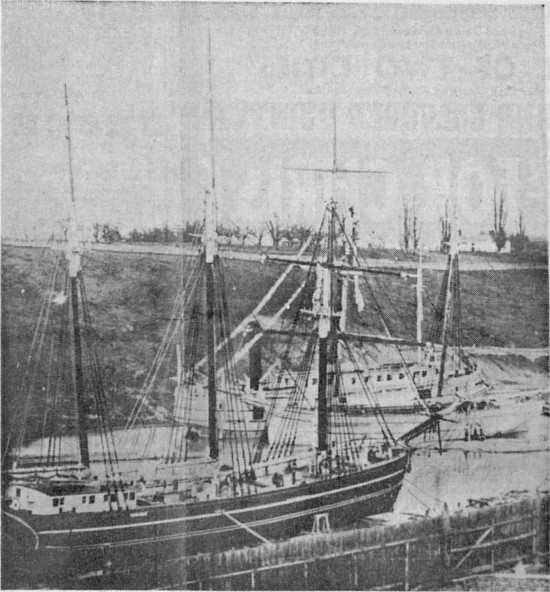Shipman's Corner put over a Fast One
Toronto Telegram, 31 May 1947
Schooner Days DCCXCVII (797)
By C.H.J. Snider

WELL away for 93, Capt. W. D. Graham of St. Catharines told this story on his recent birthday:
"They call this beautiful place the Garden City, and so it is, especially this time of year, with the fruit trees frothing, and lilacs and chestnuts beginning to show their tassels and tapers, and the tulips in every garden making robin redbreast look rusty. But before it won that name, or its name of St. Catharines, it was the village of Shipman's Corners. Considering the hundreds of craft, steam, sail and tow, whose keels first kissed fresh water in this place, Shipman's Corners wouldn't be a bad name for it yet.
Back to Adams
There was a man named Adams – J. Adams, as I remember – owned twenty-one acres of land right in the village limits. Say about 1862, time of the American War, Lewis Shickluna, ship carpenter from the Royal Naval dockyard in Malta, built his thirtieth or fortieth schooner, here in his yard. Shickluna was one of the early builders on the lakes At first he was foot-loose and built where business called him. He built several vessels at Lewiston, his first there being the new American R. H. Boughton, second vessel through the new Welland Canal, when it joined Lake Erie with Lake Ontario in 1829. By the middle of the century he was well established in his little old yard and drydock in St. Catharines on the Welland Canal.
Last of old style
"This vessel he built, of which I'm speaking, was about the last of the old standing-keelers. By the 1860's the deep draft standing keels were out and everything that sailed had a centreboard if she was of any size. Even barges and steamers had them, for they carried auxiliary sail and even if they had none the centreboard gave them a better hold on the water and kept them from drifting to leeward, while at same time their draft was kept shoal.
It is claimed that the centreboard was introduced on the lakes in a schooner built in Oswego at the foot of Cayuga street in 1806 or 7, a skiff from the Niagara river furnishing the model. Slip-keels, which are much the same thing, were in use in 1813, and from then onwards the centreboard became characteristic of lake vessels.
"This new vessel, however, had no centreboard, but was built with a standing keel, and therefore a roomy easily stowed hold. Up to the 9 feet draft, then the limit in the Welland and St. Lawrence Canals, she was very trim, being sharp of good lines. But loaded to the twelve-foot mark, as she could be when the canal was deepened, she was 90 percent box.
"Lewis Shickluna built this schooner for Capt. James Norris, who had a large flour mill located on the Welland Canal in the city limits. She was christened "J. Adams" in compliment to the big property owner, who may have also had an interest in her, as well as in the growing city. Her master was Capt. Alex Norris.
Flour for Halifax
On her first trip they headed the Adams for Montreal, with flour in barrels from the Norris mill. On her arrival they loaded her down to the eleven-foot draft from the warehouse there and sent her on to call at Halifax to discharge and then on to Sydney, Cape Breton, to load coal for Montreal. Nova Scotian coal was in general use even then.
In those days many large and fast vessels were in the coal trade. The Adams was rather odd looking to the captains of those streamlined "barques" and barquentines. The fleet in Sydney were getting under way while the Adams loaded. She pulled out hours after the fleet had left – but she arrived at Montreal first and unloaded, and was coming out when Captain Alex met the first of his victims, only then coming in.
Wanted to copy her
She – the Adams – was in the Bluenose class. She was known by all the vessel captains and owners on the lakes. She took a cargo to Buffalo, and the Buffalo Dry Dock Company offered to dock her free, scrape her bottom, caulk her seams, and give her a new suit of sails, to allow them to make templates of her design. This was promptly refused by the owner, Capt. Jas. J. Norris, who knew a good thing when he had it.
"A few years after, when Capt. Alex Norris, her master, was near the South East shoal at the Pelee Passage in Lake Erie, the wind blowing fresh and starboard tack aboard giving him all rights-of-way, an American vessel deliberately ran her down, fortunately, without any loss of life. The Adams clipped the wings of any vessel afloat in Canada or the U.S. A., but even her smartness was not proof against the envy or stupidity at the wheel of the other vessel."
